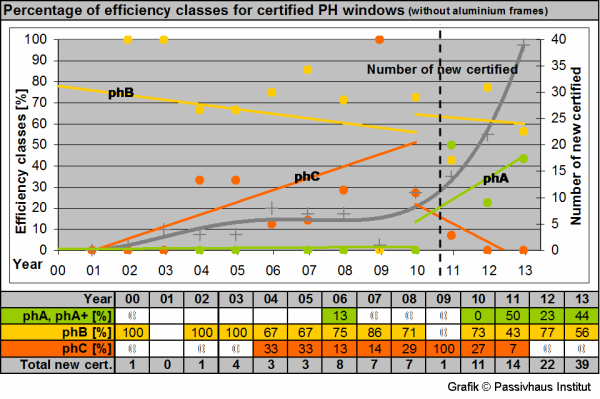Table of Contents
PHI window certification: previous success and new climate zones
Passive House window certification: a success story
One of the problems when Passive House was just getting started was that there were not yet any windows on the market with high enough quality. The required thermal qualities could only be achieved by individually improving standard windows, at times right on the construction site. To improve the situation, the Passive House Institute established a window certification program and worked together with manufacturers to develop high-quality windows for market launch. By now, more than 130 windows have been certified in 23 countries (as of February 2013), with interest in window certification growing particularly fast in the last few years; 39 new components were certified in 2013 alone. The dashed line in Figure 1 shows this impressive upswing. At the same time, products are constantly becoming both better and more affordable. Improvements in windows and glazing in particular present a lot of new opportunities. While the first Passive House buildings tended to stick to the classic passive-solar “rabbit cage” shape, today they can be built in almost any imaginable form, even in shaded urban areas. In addition, a solar-optimized building with today's windows and glazing can cut investment costs quite a bit. If the first Passive House building in Kranichstein were built today, for example, it would only need 16 centimeters of façade insulation – or as little as 9 centimeters of today's top-of-the-line insulation
Important factors in determining a window's energy balance include the thermal values for the glazing (Ug and g-value) and the frame (Uf and glass edge thermal bridge coefficient Ψg) along with the window frame surface area Af. All of these parameters are important because, on one hand, the frame tends to have a worse U-value than the glazing and, on the other hand, no direct solar gains are possible through the frame. From the parameters Uf, Ψg, and Af, relative to the length of the glass edge lg, we can derive the indicator Ψopaque, which describes losses from the opaque component. The smaller Ψopaque is (that is, the lower losses are along the edge of the glass), the greater potential solar gains through the window are. PHI used this parameter to determine classes from phC to phA+, which have been used to evaluate Passive House windows since early 2011 (cf. [Krick 2011], [Krick 2011a]):
$$
\Large{\varPsi_{opaque} = \varPsi_{g} +\dfrac{U_{f}\cdot A_{f}}{l_{g}}}
$$
After the certification program, the introduction of this classification system proved to be the second major incentive to continue improving the energy efficiency of windows. The trend toward wider frames and, in turn, worse Ψopaque values turned around within a year after the classes were introduced. In 2013, 44 percent of newly certified frames received Class A designation (with one frame earning Class A+); except for a few aluminum frames, no products were designated Class phC in 2012 and 2013 (see Figure 1).
 |
| Figure 1: Number of new certifications (dashed line and crosses) and the share of components in the efficiency classes (phA and phA+ gray, phB dark gray, phC light gray). |
Read more
References
[Feist 2011] Feist, Wolfgang: Tagungsband zur 15. Internationalen Passivhaus Tagung in Innsbruck, 2011
[Feist 2012] Feist, Wolfgang: Tagungsband zur 16. Internationalen Passivhaus Tagung in Hannover, 2012
[GLACE] http://www.euroglas.com/service/berechnungen/glace.html
[Krick 2011] Krick, Benjamin: Neue Zertifizierungskriterien für Passivhaus geeignete transparente Bauteile, in: [Feist 2011]
[Krick 2011a] Krick, Benjamin: Zertifikatskriterien und Berechnungsvorschriften für Passivhaus geeignete transparente Bauteile, Passivhaus Institut Darmstadt (2011)
[Krick 2012] Krick, Benjamin, Feist, Wolfgang: Anforderungen an Passivhaus geeignete transparente Bauteile in verschiedenen Regionen der Erde, in: [Feist 2011]
[Krick 2012a] Krick, Benjamin: Zertifikatskriterien und Berechnungsvorschriften für Passivhaus geeignete transparente Bauteile, Passivhaus Institut Darmstadt (2012)
[Krick 2014] Krick, Benjamin: Wirtschaftlichkeitsuntersuchungen zum Fenster smartwin compact der Firma Propassivhausfenster, zu veröffentlichen, Passivhaus Institut Darmstadt, 2014
[Schnieders et.al. 2011] Schnieders, Feist, Schulz, Krick, Rongen, Wirtz: „Passivhäuser für verschiedene Klimazonen“ Passivhaus Institut Darmstadt, Rongen Architekten, Wassenberg, 2011
See also
Overview of all articles on Passipedia about windows
Overview of all articles on Passipedia about “Thermal protection”
List of all released conference proceedings of the 18th International Passive House Conference 2014 in Aachen
Conference Proceedings of the 18th International Passive House Conference 2014 in Aachen
(read also in Spanish) ![]()
